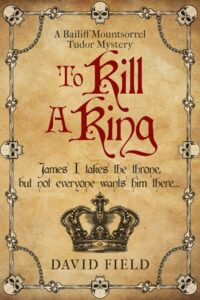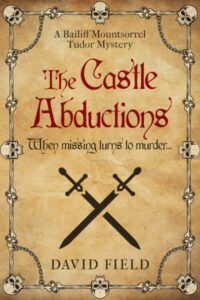Congratulations to David Field, whose absorbing historical thriller, Death By Gunpowder, is out now!
Death By Gunpowder is the sixth instalment of the Bailiff Mountsorrel Tudor Mystery Series – private investigation crime novels set during the reign of Elizabeth I and beyond.
Nottingham, England, 1605
Frustrated in their two previous attempts to restore the Catholic faith to England, a group of heretics plan to assassinate King James in Parliament in a massive explosion timed for November 5th, 1605.
But when that plot also fails and Guy Fawkes starts revealing the names of accomplices under torture in the Tower, those who had been complicit in the plot run for cover.
Not long after, Nottinghamshire bailiff, Edward Mountsorrel is called to investigate a mysterious explosion in a row of houses that has left four people dead.
And he soon unearths evidence that suggests this crime is linked to the larger plot on the king’s life.
His suspicions are confirmed when an official from London, acting with royal authority, orders Edward and fellow bailiff Francis Barton to hunt down the gunpowder fugitives who are believed to be hiding out in the local area.
But the men won’t go down without a fight. And Edward could find himself in the firing line…
Congratulations to David Field, whose gripping historical mystery, To Kill A King, is out now!
To Kill A King is the fifth novel in the Bailiff Mountsorrel Tudor Mystery Series – private investigation crime novels set during the reign of Elizabeth I and beyond.
Nottingham, England, 1603
Queen Elizabeth’s long reign has finally come to an end and the Tudor era is over. Scottish King James has been handed the crown of England, but not everyone is happy about that, and there are several plots being hatched to replace him with an alternative.
Bailiff Edward Mountsorrel already has his hands full with an increase in destitute vagrants flooding the county, who seem to be victims of a human trafficker. But before he can find the man responsible, he is tasked by an official with royal authority to infiltrate a local group, who it is rumoured are plotting to assassinate the new king.
Edward enlists the help of fellow bailiff, Francis Barton to find the group, who are hiding out in Sherwood Forest.
But the only way to discover the plot is to place themselves right in the heart of the danger. And there’s a good chance they will be killed before they can save the king…
Who is leading the band of rebels? Can he be stopped?
And is there a connection between the treasonous plot and the desperate vagrants Edward is trying to assist…?
In this behind-the-scenes blog series, Sapere Books authors offer an intriguing insight into how, where and why they write.
Today, we are delighted to spotlight David Field, author of numerous historical series including the Bailiff Mountsorrel Tudor Mystery Series and the New World Nautical Saga Series.
I’ve always written stories, even as a child, then I progressed from childhood scribbles to more serious attempts at literary glory on an old upright Olivetti typewriter (one of those with a red and black ribbon, if you’re old enough to remember) when my handwriting graduated from ‘untidy’ to ‘execrable’.
Reluctantly I then honoured my mother’s wish, and my father’s insistence, and got a ‘real job’ as a criminal trial lawyer, which was about as relaxing as standing on one leg on the top outer ledge of The Shard in London, without the reassurance of a safety harness. To relieve the stress I decided to start working on a novel — but what should I choose for a genre?
A good friend of mine who already earned a precarious living as a novelist was insistent that one should always write about things that one knows, and by this stage I knew two things outside my professional straightjacket — some history from my schooldays, and the streets of my home town, Nottingham. During the final years of my working life I spent stolen moments imagining the lives of those living in Nottingham during the Luddite Riots, and In Ludd’s Name was eventually published by a boutique publishing house owned by an old school friend.
Bitten by the bug, and buoyed up by having finally been published, I grew ambitious, and searched the history books for possible storylines, most notably from that most colourful of periods of English history, the Tudor era. The literary world seemed to be awash with Henry VIII, Anne Boleyn, Elizabeth I and even ‘Bloody Mary’, but two seminal characters from that era seemed never to have received much attention from novelists.
First was the progenitor of the Tudors, the boy from Wales, Henry VII, and I climbed inside his head to bring to the pages that followed his boyhood imprisonment in a bleak castle in South Wales, his youthful exile in Brittany, his triumphant return at the head of a ramshackle army that deposed Richard III at Bosworth, and his love match with Elizabeth of York that brought the Wars of the Roses to an end in the nursery rather than on the battlefield. To my delight, and secret surprise, I found a publisher — Sapere Books — and Tudor Dawn was launched.
Then — unbounded joy and amazement! — Sapere wanted another one, so this time I focused on a butcher’s son from Ipswich who rose from obscurity to become Archbishop of York, Papal Legate for life, Lord Chancellor and the diplomacy coach of choice of Henry VIII. Cardinal Thomas Wolsey’s spectacular downfall was just as dramatic, and The King’s Commoner was published, as testament to the fact that I had a second novel in me.
Dozens of titles have since been published, all by Sapere Books, and all ‘historical’ in genre. As one of the characters in Alan Bennett’s delightful creation, The History Boys, says of history — ‘It’s just one ******* thing after another’, and so it has been for me.
Congratulations to David Field, whose gripping historical mystery, The Slaughtered Widow, is published today!
The Slaughtered Widow is the third instalment of the Bailiff Mountsorrel Tudor Mystery Series – private investigation crime novels set during the reign of Elizabeth I and beyond.
Town Bailiff Francis Barton has been arrested for the murder of his former lover, the widow Agnes Timberlake, and the case against him is a strong one.
Agnes was hacked to death where she lay in her bed and Francis was found standing next to her body, with both his clothing and his sword covered in her blood.
And there is a motive. Agnes had recently loaned Francis her entire life savings and was believed to be demanding an accounting for them.
Despite the overwhelming evidence against him, Francis’s friend, County Bailiff Edward Mountsorrel, refuses to believe that Francis is guilty and sets out to investigate for himself.
Edward wants to speak to the serving girl from the widow’s house who may have been the last to see her mistress alive, but she has vanished.
Is the girl running from a guilty conscience? Or has she also fallen victim to the killer?
Time is running out for Francis. Can Edward clear his friend’s name … or is it time to accept that Francis really is capable of murder…?
Congratulations to David Field, whose absorbing historical thriller, The Assassination Players, is published today!
The Assassination Players is the second instalment in the Bailiff Mountsorrel Tudor Mystery Series – private investigation crime novels set during the reign of Elizabeth I and beyond.
Nottinghamshire, England, 1591
Two of Queen Elizabeth I’s justices have been murdered within a week of each other, along with a woman who was involved with one of them and a man who had been awaiting trial by the other.
County Bailiff Edward Mountsorrel and Town Bailiff Francis Barton are tasked with investigating the deaths, but they are thrown off course by a visit from the queen’s secretary, Baron Burghley.
Burghley has discovered a plot to kill the Protestant queen and replace her with a Catholic alternative.
He tasks the bailiffs with journeying into a neighbouring county to infiltrate the gang of suspected traitors.
Time is of the essence as the threat already seems to have infiltrated Elizabeth’s court.
But the men behind the plot are ruthless and the path to discover them is fraught with danger.
Will Mountsorrel and Barton unmask the traitors? Who is behind the plot to kill the queen?
Can the bailiffs stop them before they change the course of history forever…?
Congratulations to David Field, whose page-turning Tudor mystery, The Castle Abductions, is out now!
The Castle Abductions is the first historical thriller in the Bailiff Mountsorrel Tudor Mystery Series: private investigation crime novels set during the reign of Elizabeth I and beyond.
County Bailiff Edward Mountsorrel and Town Bailiff Francis Barton have vowed to root out the criminals of Nottinghamshire and bring them to justice.
But after acting on information from a questionable source, Edward is tricked into allowing several deer to be stolen from a local estate. Furious, he sets about tracking them down.
Meanwhile, Francis is asked to investigate the disappearance of Nell, a young woman who was last seen at a local alehouse with a wealthy stranger.
When the bailiffs’ shared house is burned down and their servant is found stabbed to death, Edward and Francis begin to suspect that their cases are linked.
And when more young women go missing, the two bailiffs worry they are running out of time to retrieve them from danger…
Who wishes to silence to Edward and Francis? What happened to the missing women?
And can the two bailiffs find them before it’s too late…?
David Field is the author of numerous historical series, including the Bailiff Mountsorrel Tudor Mystery Series: private investigation crime novels set during the reign of Elizabeth I and beyond.
My new series features the exploits of two sheriffs’ bailiffs during the Tudor and later the Stuart eras. For me it was a labour of love because it involved researching the history of Nottingham, where I was born and raised during the immediate post-war years.
In my novels, Edward Mountsorrel and Francis Barton are colleagues in adjoining jurisdictions who have become close friends. Their work involves enforcing the law and investigating crime, under the direction of their respective employers, the Sheriff of Nottinghamshire and the Sheriff of Nottingham. The fact that there are two separate sheriffs, one for the county and the other for the town, arises from a quirk of Nottingham’s history that also explodes one of the elements of the legend of Robin Hood, Nottingham’s most famous alleged resident.
A central character in the Robin Hood myth is the dastardly Sheriff of Nottingham, but the truth is that he did not exist until 1449, at least two hundred years after Robin is said to have lurked in Sherwood Forest, to the north of the town. A charter in that year, granted by Henry VI, made Nottingham its own county, with its own sheriff and its own jurisdiction, not to mention its own courthouse. And therein lies another set of intriguing and quirky facts.
While the town continued to conduct its legal affairs in the old Guildhall in Weekday Cross, the county needed a place to do the same, conveniently located within the town itself. It therefore constructed what for many years was known as the Shire Hall, sitting proudly in the middle of one of the town’s most affluent streets, High Pavement. It was a small chunk of the county located within the town, and given that the boundary line ran through the centre of the original courtroom, the judge could be found seated in the town while the prisoner before him was located in the county. This august building is now the National Justice Museum, a popular destination for tourists.
Hopefully this will make up for several guaranteed disappointments for any tourist visiting Nottingham hoping to step into the Medieval world of Robin Hood. The city does indeed possess a castle, which features heavily in the first book in my forthcoming series, but the current edifice is now in its third manifestation. The original eleventh-century version constructed on the orders of William the Conqueror was destroyed at the behest of its own governor, Colonel John Hutchinson, at the end of the English Civil War, before Oliver Cromwell could get his hands on it. The reconstruction was then burned down by a mob during the Reform Bill Riots of 1831, and the current building — which is now a civic museum that houses old bicycles, coin collections and Japanese armour — became little better than a middle-class boarding house of dull Victorian architecture before being bought up for a song by the embarrassed city fathers.
At least the vandals couldn’t do much to diminish the grandeur of the rock on which the castle stands, a block of sandstone rising for one hundred and thirty feet above ground level. This is full of caves and passages where previous generations cut their way through the soft stone in order to create dwellings that were converted into dungeons when the castle was first constructed. At its foot sits a vintage hostelry, now known as The Ye Olde Trip to Jerusalem, that was once the castle’s in-house brewery before it became an alehouse, linked to the castle above by a series of tunnels through the sandstone. This alehouse would have been there during the time in which my novels are set, so I’ve made use of it in the first instalment, in which young women are abducted from there.
I enjoyed researching the history of my birthplace, and I think it shows in my new series, which hopefully captures the rough-and-tumble nature of law enforcement in a Tudor township.


